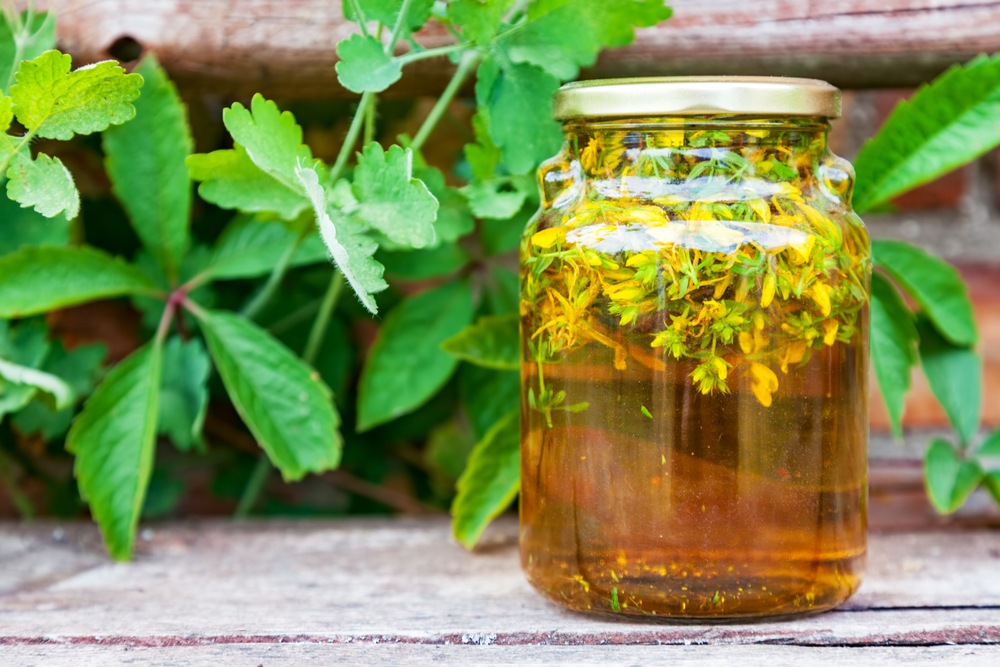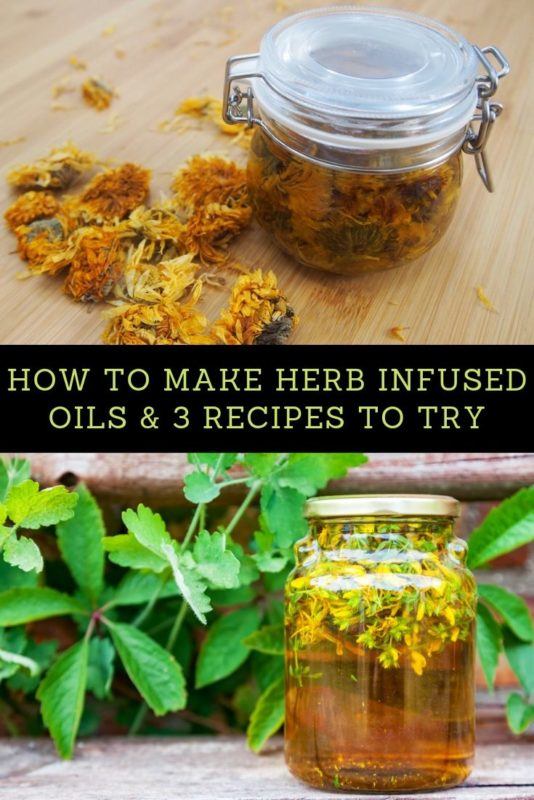
Making herb-infused oils at home is relatively easy – and a fun project to start out with if you are new to making natural care products. Even if you only have a few herb pots on your kitchen window sill, you’ll probably have enough material to get started in making your first herb-infused oil.
Here’s a quick look at how to make herb-infused oils – and some suggestions on what you can do with your finished oil!
Infusing Herbs Into Oil
You need just a few basic materials to get started infusing oils. You will need:
- A clean, sterile jar (such as a Mason jar).
- A carrier oil of choice. I suggest sunflower (Helianthus annuus), olive (Olea europaea), or sweet almond (Prunis dulcis) oil as your base oil. See the recipes below for suggestions.
- An herb of choice. There are many plants (not just herbs) that you can choose to infuse but I suggest starting out with some of the more popular (and readily available) herbs suggested in the recipes below.
- Sunshine or a heat source. See below for the two main methods for making herb-infused oils.
How To Dry Fresh Plant Material To Make An Herb-Infused Oil
If you are using fresh plant material, vs. store-bought plant material which is already dry, you need to make sure that your plant material is dried out first. Failure to dry your plant material will result in a moldy, unusable oil, due to water retained within the plant material.
How To Dry Out Fresh Plant Material:
- Lay flat your fresh plant material on tissue paper in a warm, humid-free space and leave to dry for one to two days (depending on your climate and space available) OR
- Tie a few stems of the fresh plants together with a piece of string and hang upside down from the rafters of the roof. Some people also cover the bunch of herbs with a paper bag. Make sure that the area is warm but moisture-free.
Packing A Jar For An Herb Solar Infusion
Once you have dried plant material, break it down into manageable parts that will fit inside of the Mason jar; for example, leaves, stems, flowers. Pack the jar as tightly as you can. Leave enough space to pour in your chosen carrier oil. You may need to add more plant material when you’ve added the oil, and over subsequent days, as the material moves around.
When the jar is full of both plant material and oil, cap tightly, and shake gently a few times.
Herb-Infused Oils With Solar Infusion
If you choose to use the solar infusion method, you’ll need to make sure that you have a warm, sunny window sill available for two to four weeks or a place to put the jar outside for long days of sunshine. Simply place the jar in the chosen sunny spot and leave for two to four weeks. Check on it every few days, shake gently, and add more plant material if necessary.
After two to four weeks, strain the plant material from the herbs, and pour the oil into another Mason jar.
Infusing Herbs By The Double Boiler Method
The double-boiler method is quicker but less traditional than the solar infusion method to make herb-infused oils. Once the herbs are dried, place the herbs in the top pan of the double boiler. Cover with your chosen carrier oil.
You can make a simple double boiler by placing two pans inside of each other.
The bottom pan should contain about two inches of water. Heat up this water on the stove. When it is boiling, turn down to simmer, and then place the top pan inside of the first pan and cover. The bottom of the top pan should sit just above the water in the first pan (not touching). Leave to simmer for several hours. However, you need to constantly check the water level in the bottom pan and check on how the oil and plant material is interacting. Once the oil changes color and/or takes on the aroma of the herbs, switch off the heat.
Strain the herbs from the oil by using a strainer. Pour the oil into a suitable container (such as a Mason jar).
Simple Recipes Using Herb-infused Oils
Whichever method you used to make your herb-infused oil, you should now have an herb-infused oil. Following are three suggestions for making herb-infused oils and what you can do with your oil once you have made it.
Calendula Infused Oil
Calendula infused oil is a favorite herb-infused oil to make as it can be used for many things. It is an excellent skincare oil and is gentle enough to use on babies bottoms!
- Calendula Infused Oil for Baby Bottoms
- 1-oz. calendula infused sunflower (Helianthus annuus) oil
Combine the calendula-infused oil with the essential oil. Apply to baby bottoms to soothe mild diaper/nappy rash or skin issues.
Cautions: Use only on babies age 6 months and above. Leave out the lavender essential oil if you have concerns about skin sensitivity. Consult a medical professional immediately, if adverse reactions occur.
Chamomile Infused Oil
Chamomile is also a useful oil to have around for skincare.
- Chamomile* Infused Oil for Cracked Skin
- 1-oz. chamomile-infused* sweet almond (Prunis dulcis) oil
- 2 drops rose (Rosa × centifolia) essential oil
*Use either Roman (Chamaemelum nobile) or German (Matricaria recutica) chamomile plant.
Combine the chamomile-infused oil with the essential oils. Apply the oil blend to dry or cracked skin.
Cautions: Do not apply to open wounds. Possible skin sensitivity.
Peppermint & Rosemary Infused Oil
This is a more complex recipe that involves combining two infused oils. Both peppermint and rosemary are great for mental stimulation and for calming the soul.
- Peppermint and Rosemary Infused Oil Roll-on for Clarity
- 0.33-oz. (10 mL) peppermint and rosemary infused* olive (Olea europaea) oil
- 1 drop basil (Ocimum basilicum) essential oil
*Infuse both the peppermint and rosemary as separate infusion blends and combine together for this recipe.
Combine the peppermint and rosemary infused oil with the essential oils. Pour into a roll-on applicator. Fix the roller ball applicator and cap. Shake well. Apply to wrists and temples in times of brain fog and confusion.
Cautions: Avoid during pregnancy. Avoid with high blood pressure. Possible skin sensitization. For adult use only.
The Use Of Herb-Infused Oils
Herb-infused oils can often be used in place of essential oils, although therapeutic properties may vary due to the different extraction methods. Herb-infused oils can be made at home with relative ease and are less expensive to make (and use) than essential oils. However, combining both herb-infused oils and essential oils adds a different dimension to aromatherapy blends, and the possibilities are limitless!
Pin This To Save For Later

